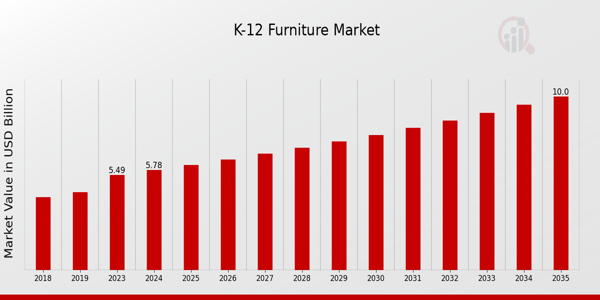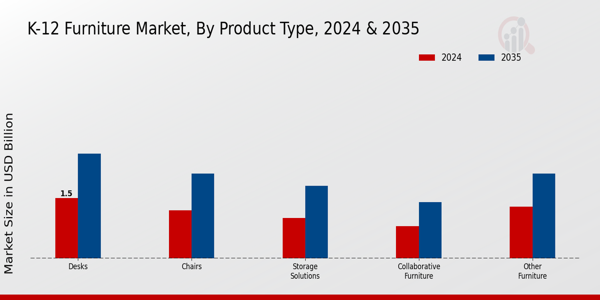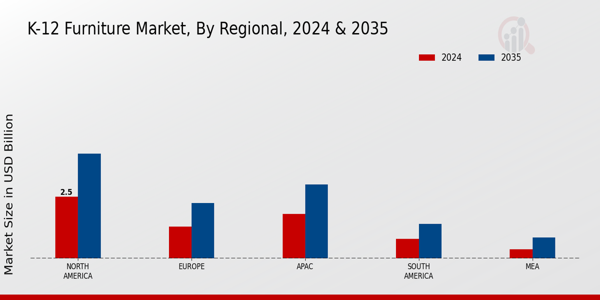K-12 Furniture Market Overview
The K-12 Furniture Market Size was estimated at 5.49 (USD Billion) in 2023. The K-12 Furniture Market Industry is expected to grow from 5.78(USD Billion) in 2024 to 10.0 (USD Billion) by 2035. The K-12 Furniture Market CAGR (growth rate) is expected to be around 5.12% during the forecast period (2025 - 2035).

Source Primary Research, Secondary Research, MRFR Database and Analyst Review
Key K-12 Furniture Market Trends Highlighted
The K-12 furniture market which spans across the globe is exhibiting considerable growth owing to several factors. Schools are rapidly expanding and modernizing both their standards and infrastructure, with an increasing emphasis on meeting ergonomic standards in furniture and equipment. There is also a growing need to repurpose learning environments, in which students are encouraged and enabled to perform a variety of tasks as a team. Moreover, the increasing use of multi-functional digital devices is changing the classroom layout, thus bringing about a new interrelationship between furniture and technology, demanding the former to become more flexible. As a result of health and safety issues, for instance, schools are looking for suitable furniture for kids, which is increasing the need in the area.
The manufacturers who devise sustainable and environment-friendly products have much nature of opportunities in the market. Green education brings into opportunities of product innovation where people have developed needs and want of what they can’t have. Design customisation is also a new trend that is gaining momentum whereby the furniture manufactured for schools is required to be in tune with the school’s brand and functional requirements. Also, there is a gap that has been realised with the learners most especially now days being snowed under with remote learning where comfort and effective studying environment is needed. Such kind of diversification may help to broaden the market and promote better growth opportunities. Current developments show that there is a gradual move toward the use of technologies in the design of furniture including equipping furniture with charging ports and interactivity.
We note growing concerns of schools in particular toward the purchase of furniture that is able to offer both physical and mental wellbeing, especially the impulse to use adaptive seating and rolling. With the advancement of education, ergonomic and flexible furniture is vital. Thus, what was a collection of static and loose furniture has transformed into a dynamic climate set comprising changes in the growing K-12 furniture market economics. Teacher or Designated admin users are now able to create layouts for the classroom with adjustable desks, furniture, and specialized devices.
K-12 Furniture Market Drivers
Increasing Focus on Student-Centric Learning Environments
The K-12 Furniture Market Industry is experiencing significant growth due to the increasing focus on student-centric learning environments that cater to the diverse needs of students. As educational institutions shift their pedagogical approaches towards more interactive and collaborative learning methods, the demand for innovative furniture solutions rises. This trend emphasizes the importance of flexibility and adaptability in classroom layouts, encouraging educational facilities to invest in furniture that fosters engagement and participation among students.
The evolution of classroom designs involves creating multi-functional spaces that can be easily reconfigured to support various teaching styles and group dynamics. Moreover, the emphasis on ergonomics plays a crucial role in enhancing the well-being and productivity of students, leading to the introduction of furniture that is designed to provide comfort while also accommodating different learning activities. In this context, the growth of the K-12 Furniture Market is closely tied to the vision of creating conducive learning environments that prioritize students’ needs, thereby promoting academic success and encouraging an interactive learning culture.
Technological Advancements in Furniture Design
Technological advancements are driving innovation in the K-12 Furniture Market Industry, leading to the development of smart furniture solutions that integrate technology seamlessly into learning spaces. Schools are increasingly adopting furniture equipped with charging ports, built-in connectivity features, and multifunctional designs that support technology use in the classroom. This shift towards technology-enhanced environments not only facilitates the use of digital tools and resources but also enhances collaborative learning experiences among students.
As educational institutions invest in modernized infrastructure, the demand for high-quality, tech-friendly furniture is expected to grow significantly.
Rising Investments in Educational Infrastructure
The increasing investments in educational infrastructure ly are a critical driver for the K-12 Furniture Market Industry. Governments and private institutions are focusing on upgrading and renovating existing schools while establishing new educational facilities to accommodate growing student populations. This trend leads to a greater need for quality furniture that meets the latest educational standards and provides an engaging and effective learning environment.
As new educational policies emphasize the importance of holistic development, the demand for functional and stylish furniture solutions continues to rise, further propelling market growth.
K-12 Furniture Market Segment Insights
K-12 Furniture Market Product Type Insights
The K-12 Furniture Market is projected to experience substantial growth, particularly within its Product Type segment, which encompasses Desks, Chairs, Storage Solutions, Collaborative Furniture, and Other Furniture. In 2024, the market shows a promising valuation with desks commanding a notable share at 1.5 USD Billion, which is projected to grow to 2.6 USD Billion by 2035. Desks, being essential for student learning environments, hold a significant position, accounting for a majority holding in the market due to the pivotal role they play in fostering productive educational experiences. Chairs are also vital, valued at 1.2 USD Billion in 2024, increasing to 2.1 USD Billion by 2035. This segment reflects the necessity of ergonomic and flexible seating arrangements in classrooms, supporting various learning styles and encouraging longer attention spans among students.
Storage Solutions contribute 1.0 USD Billion in 2024 and are expected to rise to 1.8 USD Billion by 2035. This segment is crucial for maintaining organized learning environments, facilitating easy access to materials and resources, thus enhancing educational efficiency. Collaborative Furniture, while projected to grow from 0.8 USD Billion in 2024 to 1.4 USD Billion in 2035, emphasizes the growing trend towards teamwork and group activities in educational settings, allowing for fluid space reconfigurations that promote interactive learning. Meanwhile, the Other Furniture category, reflecting diverse needs beyond conventional pieces, is valued at 1.28 USD Billion in 2024 and is anticipated to reach 2.1 USD Billion by 2035, showcasing the demand for multifunctional furniture that accommodates various preparations within educational frameworks.
As a whole, the K-12 Furniture Market demonstrates robust growth propelled by evolving educational methodologies and increased awareness of ergonomics and functionality in classroom setups. Factors such as rapid urbanization, growing student populations, and rising investments in educational infrastructure significantly drive demand within all product segments. However, challenges such as budget constraints faced by educational institutions could impact purchasing decisions. Nonetheless, opportunities also arise from sustainable furniture solutions and technological integration into designs, which promise enhanced learning environments and user experiences. The market's diversified Product Type segment thus reflects both the fundamental needs of educational institutions as well as emerging trends that may shape future investments in K-12 furniture.

Source Primary Research, Secondary Research, MRFR Database and Analyst Review
K-12 Furniture Market Material Insights
In 2024, the K-12 Furniture Market is expected to be valued at approximately 5.78 billion USD, driven by diverse material applications in educational settings. The choice of materials such as wood, metal, plastic, fabric, and composite materials plays a crucial role in shaping the quality and durability of K-12 furniture. Wood remains a prevalent choice due to its natural aesthetic and resilience, appealing to those who value traditional design. Metal furniture, on the other hand, is recognized for its strength and longevity, making it suitable for high-traffic environments.
Plastic materials are gaining traction due to their lightweight characteristics and ease of maintenance, catering to a modern aesthetic while being budget-friendly. Fabric is often used for seating solutions, addressing comfort and design versatility in learning spaces. Lastly, composite materials are becoming significant for their ability to combine benefits from various substances, thus enhancing functionality and appearance. The growth in the K-12 Furniture Market revenue is underpinned by trends emphasizing sustainability and ergonomics, further elevating the importance of material choices in educational infrastructures.
Growth drivers include increasing enrollment rates and enhanced funding for educational facilities, while challenges may arise from fluctuating material costs and sustainability concerns.
K-12 Furniture Market End User Insights
The K-12 Furniture Market revenue for the End User segment is poised for significant growth as it caters to various educational institutions, including Primary Schools, Secondary Schools, Public Schools, Private Schools, and Vocational Schools. As of 2024, the market is expected to reach a valuation of 5.78 billion USD, reflecting the increasing emphasis on creating conducive learning environments. Primary Schools play a crucial role in this segment, emphasizing ergonomic furniture solutions that support young learners' development. Secondary Schools are also significant contributors, focusing on adaptable and collaborative furniture to enhance student engagement.
Public Schools generally represent a sizable portion of the market, as they often have larger budgets for furniture acquisition. Private Schools often invest in specialized furnishings to create unique, tailored learning spaces. Furthermore, Vocational Schools are gaining attention due to their need for functional furniture that supports trade-specific training, enhancing student hands-on experience. With changing educational trends and a focus on student well-being, the K-12 Furniture Market segmentation reflects diverse preferences and requirements across these segments, driving market growth and presenting numerous opportunities for innovation and product development.
K-12 Furniture Market Distribution Channel Insights
The K-12 Furniture Market, valued at 5.78 billion USD in 2024, shows significant growth potential, driven by various distribution channels. A notable trend is the rise of Online Retail, which has transformed purchasing dynamics, offering convenience and broader access to products. Meanwhile, Direct Sales remain a crucial channel, facilitating personalized service and tailored solutions for educational institutions. Distributors play a vital role in ensuring widespread availability and efficient logistics, while Wholesalers contribute to cost-effective supply chain management.
Retail Stores, although facing competition from online platforms, continue to provide a tactile shopping experience essential for furniture selection. This diverse landscape of distribution channels enhances the K-12 Furniture Market segmentation, supporting various customer preferences and evolving market demands. The growth trajectory indicates that these channels will continue to adapt, with increasing importance on e-commerce and logistics optimization to meet the expanding needs of educational facilities, thus influencing K-12 Furniture Market revenue positively.
The market dynamics suggest that companies should focus on enhancing their distribution strategies to seize emerging opportunities and navigate potential challenges in this competitive space.
K-12 Furniture Market Regional Insights
The K-12 Furniture Market is displaying significant growth across various regional segments. In 2024, the North America segment holds a majority share, valued at 2.5 USD Billion, projected to rise to 4.25 USD Billion by 2035, indicating its dominance in the market. Europe follows with a valuation of 1.3 USD Billion in 2024, which is expected to reach 2.25 USD Billion by 2035, reflecting a notable increase driven by educational reform and modernization of schools. The APAC region is also growing, starting at 1.8 USD Billion in 2024 and anticipated to grow to 3.0 USD Billion by 2035, bolstered by rapid urbanization and increasing investments in education.
South America, valued at 0.8 USD Billion in 2024, shows potential for growth, reaching 1.4 USD Billion by 2035, although it remains the smallest market segment due to varying levels of educational infrastructure. Lastly, the MEA region, with a modest valuation of 0.38 USD Billion in 2024, is expected to grow to 0.85 USD Billion by 2035, reflecting its ongoing development in the education sector. This diverse regional landscape presents opportunities and challenges, driven by market trends and the need for innovative educational solutions.

Source Primary Research, Secondary Research, MRFR Database and Analyst Review
K-12 Furniture Market Key Players and Competitive Insights
The K-12 Furniture Market is characterized by a diverse array of companies vying for dominance in providing innovative, functional, and aesthetically pleasing furniture solutions that cater specifically to educational institutions. In this competitive landscape, manufacturers and suppliers aim to meet the evolving needs of students and educators by offering customizable, ergonomic, and sustainable products. Rapid advancements in design and materials technology have enabled businesses to create multifunctional furniture that not only supports physical comfort but also enhances the learning environment. Companies must therefore differentiate themselves through unique selling propositions, focusing on design flexibility, durability, and sustainable practices to attract schools and educational institutions that prioritize quality in their learning spaces.
Herman Miller has established a notable presence in the K-12 Furniture Market through its commitment to elevating educational environments with its cutting-edge designs and innovative solutions. The company's strength lies in its rich historical design heritage, which enables it to create products that are not just functional but also foster collaboration and engagement among students. Herman Miller continuously invests in research and development to ensure that their furniture is aligned with modern pedagogical strategies, which focus on active learning and flexibility. Their ability to produce environmentally sustainable furniture aligns with the growing trend in educational institutions demanding responsible sourcing and manufacturing processes. This focus on quality and sustainability, combined with a strong reputation in ergonomic design, positions Herman Miller competitively in the K-12 market.
School Outfitters distinguishes itself in the K-12 Furniture Market by providing a comprehensive selection of furniture solutions tailored specifically for schools and educational facilities. Their product range includes desks, chairs, storage, and collaborative furniture that meet the varied needs of diverse learning environments. The strength of School Outfitters lies in its ability to offer customization options, allowing schools to design spaces that reflect their specific brand and educational philosophy. Furthermore, their efficient supply chain and robust customer service ensure timely delivery and support, making them a preferred choice among educational institutions. Their commitment to affordability without compromising quality enables School Outfitters to penetrate various market segments effectively, appealing to public, private, and charter schools looking to optimize their classroom environments.
Key Companies in the K-12 Furniture Market Include
- Herman Miller
- School Outfitters
- Steelcase
- Correll
- K12 Lab Handson
- SCHOOL SMART
- Horizon Furniture
- Draper
- Bretford
- Demco
- Virco
- Smith System
- SCHOOLIN
- Fellowes Brands
- Kidmoto
K-12 Furniture Market Industry Developments
Recent news in the K-12 Furniture Market has highlighted various developments impacting the sector. Companies such as Herman Miller and Steelcase continue to innovate in ergonomic designs, aligning with the growing trend towards flexible learning environments. This shift is pushing educational institutions to invest in adaptive furniture that fosters collaboration and comfort among students. School Outfitters and Virco have introduced sustainable product lines, catering to an increasing demand for eco-friendly materials in school furniture. Furthermore, there have been notable acquisitions within the market, including the integration of new technologies by K12 Lab Hands-on, enhancing interactive learning spaces. Current affairs reflect a significant uptick in market valuation for companies like Demco and Fellowes Brands, driven by an increased focus on functional and durable classroom solutions. The emphasis on creating safe and conducive learning environments has resulted in an expansion of product offerings, with manufacturers ramping up production to meet the rising demand. Overall, the K-12 Furniture Market is experiencing dynamic growth, shaped by evolving educational needs and innovations in design and functionality.
K-12 Furniture Market Segmentation Insights
K-12 Furniture Market Product Type Outlook
- Desks
- Chairs
- Storage Solutions
- Collaborative Furniture
- Other Furniture
K-12 Furniture Market Material Outlook
- Wood
- Metal
- Plastic
- Fabric
- Composite Materials
K-12 Furniture Market End User Outlook
- Primary Schools
- Secondary Schools
- Public Schools
- Private Schools
- Vocational Schools
K-12 Furniture Market Distribution Channel Outlook
- Online Retail
- Direct Sales
- Distributors
- Wholesalers
- Retail Stores
K-12 Furniture Market Regional Outlook
- North America
- Europe
- South America
- Asia Pacific
- Middle East and Africa
|
Report Attribute/Metric
|
Details
|
|
Market Size 2023
|
5.49(USD Billion)
|
|
Market Size 2024
|
5.78(USD Billion)
|
|
Market Size 2035
|
10.0(USD Billion)
|
|
Compound Annual Growth Rate (CAGR)
|
5.12% (2025 - 2035)
|
|
Report Coverage
|
Revenue Forecast, Competitive Landscape, Growth Factors, and Trends
|
|
Base Year
|
2024
|
|
Market Forecast Period
|
2025 - 2035
|
|
Historical Data
|
2019 - 2024
|
|
Market Forecast Units
|
USD Billion
|
|
Key Companies Profiled
|
Herman Miller, School Outfitters, Steelcase, Correll, K12 Lab Handson, SCHOOL SMART, Horizon Furniture, Draper, Bretford, Demco, Virco, Smith System, SCHOOLIN, Fellowes Brands, Kidmoto
|
|
Segments Covered
|
Product Type, Material, End User, Distribution Channel, Regional
|
|
Key Market Opportunities
|
Sustainable furniture materials, Smart classroom integration, Customizable ergonomic designs, Growing online education impact, Emerging markets expansion
|
|
Key Market Dynamics
|
Increasing enrollment rates, Sustainable material demand, Technological integration in design, Government education funding, Customizable furniture solutions
|
|
Countries Covered
|
North America, Europe, APAC, South America, MEA
|
Frequently Asked Questions (FAQ) :
The K-12 Furniture Market is expected to be valued at 5.78 USD Billion in 2024.
The market is projected to reach 10.0 USD Billion by the year 2035.
The expected CAGR for the K-12 Furniture Market during this period is 5.12%.
North America holds the largest market share, valued at 2.5 USD Billion in 2024.
Europe's market valuation is expected to rise to 2.25 USD Billion by 2035.
The market value for storage solutions is projected to be 1.0 USD Billion in 2024.
Key players include Herman Miller, School Outfitters, Steelcase, Correll, and Virco, among others.
The market size for chairs is anticipated to reach 2.1 USD Billion by 2035.
Collaborative furniture is valued at 0.8 USD Billion in the year 2024.
The market is expected to see growth in all regions, particularly in North America and Europe, with significant increases in valuations.

















